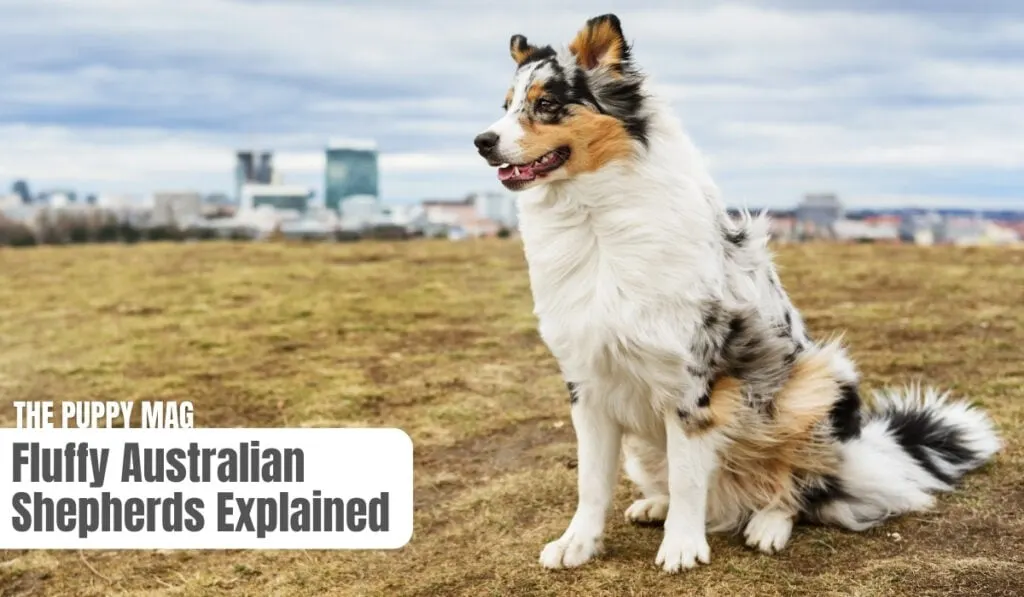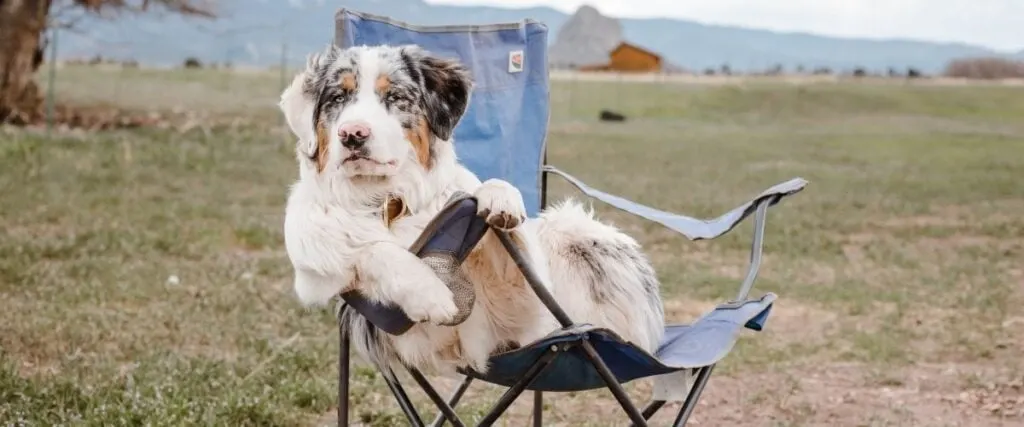Is your Aussie not as fluffy as others? We get asked about this a lot, and we’ve got some answers!
It turns out, that coat fluffiness can be affected by a few different things. This article explains the reasons why your Australian Shepherd isn’t fluffy, and what you can do about it.
Let’s explain everything below.

Table of Contents
Are Australian Shepherds Supposed To Be Fluffy?
Australian Shepherds are not all supposed to be fluffy. Their coat has a range of textures from soft, fluffy, coarse, and even quite bristly.
Australian Shepherds have thick double-coats that are typically long in length.
This, however, varies, and some Aussies may have a relatively short coat.
The undercoat is thick, soft, and fluffy. This layer sits on top of the skin and usually sheds (blows) twice per year (depending on the climate where you live).
The undercoat is certainly the softest fur that the Aussie has, but this is mostly hidden and covered by the topcoat.
The topcoat is the outermost coat that we can physically see.
The topcoat is always more coarse and rigid than the undercoat and is usually referred to as “guard hairs”.
The topcoat on males is usually more frilly around the neck and front legs compared to the females.
So, are Australian Shepherds supposed to be fluffy? Well, no, not really. The double coat of an Australian Shepherd naturally ranges with its finish, some being fluffy and others, quite coarse. Not all Aussies have naturally fluffy coats.
Trending: How to Handle Australian Shepherd Shedding (The Easy Way!)
4 Reasons Your Australian Shepherd Isn’t Fluffy
The question that brought you here! Let’s get to it.
If you’re like most Aussie owners, you assume that your Aussie should be fluffy, but it may not be the case.
Check out the following reasons why your Aussie may not be fluffy. After that, I’ll run through some best practices to keep his coat healthy and strong.
➡️ It’s because of genetics
Genetics is likely going to be the main factor as to whether your Aussie’s coat is fluffy or not.
It’s normal for owners to be unfamiliar with the parents of their dog, but the answer lays there.
You might have heard people mention aussie working coat vs. show coat, and this is generally what they’re talking about…
If the parents of your Aussie were both working dogs, living outside or spending most of their days outside, their coat will develop to be tougher, stronger, and more weather-resistant.
This physical trait is very likely to pass on to future offspring.
However, if there are any show dogs anywhere in your Aussie’s family lineage, you have a stronger chance of his coat being fluffy and soft.
Show dogs are known for having extremely soft, fluffy, well-groomed coats.
➡️ It’s down to their diet and food
Diet and nutrition play a huge role in the overall health of your Aussie’s skin and coat.
There is certainly a chance that your Aussie’s coat isn’t as fluffy, shiny, or healthy as could be, due to an issue with their diet or nutrition.
Working dogs like Aussies thrive off a diet that’s high in protein, medium to high fats, and low carbohydrates.
The quality of the dog food is SUPER important and varies dramatically depending on the brand.
On top of using premium dog food where the ingredients are as fresh as possible, the actual food needs to agree with your Aussie too… It’s true that even the best brands don’t work well with some dogs.
So it’s important that your Aussie really suits the food, and this is just a matter of trial and error.
Ensure the diet is high in vitamins, minerals, antioxidants, healthy fats, and especially omega 3, which will provide your Aussie with the best chance of having a healthy coat.
Our recommendation: Orijen Original Six Fish. This is perhaps one of the best foods on the market, and due to the use of whole oily fish, it contains a lot of healthy fats, omega 3’s omega 6’s, and DHA, which again, are excellent for skin and coat health.
Recommended Read: When do Australian Shepherds Stop Growing (full timeline)
➡️ It’s down to grooming
Double-coats require a lot of attention and manual work on your part. Let me explain the key points…
When it comes to bathing your Aussie, the ideal bathing frequency is only 3-4 times per year (or even less). Bathing more than this increases the chances of drying out your Aussie’s skin and coat, leaving it dry, dull, and not fluffy!
Oh, and you should only ever use a natural ingredient dog shampoo, anything else is a no-no!
Brushing is super important and should be around 4-5 times per week.
Many people make the mistake of putting off brushing until they absolutely have to, and then try to give their dog a 1-hour session.
Brushing is MUCH more effective when done little and often, so four to five, 20-minute sessions per week, is better than one single brushing session for longer.
Brushing will help keep old dry, dead, and dull fur out of the coat, often giving the appearance of a fresh coat. This could improve the fluffiness after a while of consistent brushing (the two best brushes for Aussies!).
Brushing also acts as a gentle massage, stimulating healthy oil production from the skin. Natural oils found in the skin and coat are essential for a healthy, shiny, and strong coat.
➡️ It’s down to health
Last but not least, certain health conditions can directly and indirectly affect your Aussie’s skin and coat.
Some issues can make your Aussie’s coat dull, greasy or brittle, and in otherwords, not fluffy!
This can also happen if an Aussie is on medication to manage an existing health issue.
With health issues, there are usually a range of symtpoms like vomiting, diarrhea, food refusal, lethargy and a general change in behavior, so if you do see any of these it’s worth contacting your vet.
Important read: What causes excessive hair loss in Australian shepherds
The Puppy Mag Favorites
👍 Set & Forget Interactive Dog Toy
Perfect for mental stimulation.
😍 The No.1 Low Calorie Dog Treat
Perfect for healthy treat-giving.
Can You Make Your Australian Shepherd Fluffier?

Fluffy coats are desirable, they look better and it makes your Aussie more cuddly, so is there a way you can improve the fluffiness?
Although you may be able to improve coat health and quality, there is no guaranteed method to make your Aussie’s coat genuinely fluffy.
But here are some tips to help you keep your Aussie’s coat as healthy as possible.
1. Have a proper brushing routine
As outlined above, a brushing routine is super important to remove dead fur from the undercoat as well as stimulate blood flow to the skin and encourage natural oil to spread throughout the coat.
This all plays an important part in overall coat health and appearance.
2. Make fish their main protein source (ideally salmon)
Skip on the chicken, beef, lamb, or pork and opt for a dog food that uses fish as the main protein source.
This usually digests better plus there will be a higher content of healthy fats, especially omega 3 and DHA’s. These are essential for skin and coat health
3. Don’t bathe him as much
Keep bathing to no more than 3 or 4 times per year, and when you do bathe him, use a natural ingredient dog shampoo only.
Other shampoos, even regular pet shampoo contain harsh chemicals that strip the skin and coat from their natural oils.
4. Keep exercise high
Aussies are a high-energy working breed and require 1-2 hours of exercise per day. Ensuring that you keep his exercise high will keep his body fit and healthy.
Overall health plays a huge part in skin and coat health.

Psst. A word on training while we are here. We’ve had so many Aussie owners report great things about Brain Training For Dogs we’ve got to recommend it here. From increased obedience, behavior, and reduced stress, the results speak for themselves. Okay back to the article!
One Thing You Should NOT Do To Their Coat
Although this is now widely accepted, Australian shepherds should never be shaved.
There are still some groomers who advocate shaving or trimming a double-coated breed. This really shouldn’t be done!
The double-coat plays an important role in both summer and winter for any breed that has one. It’s a common misconception to think that shaving will allow the dog to feel cooler. This isn’t true.
The undercoat and the topcoat are both crucial for the health of your Aussie and shaving it could compromise that. UV blocking, insect bite preventing, skin protection, the list goes on and on.
The undercoat grows back faster than the topcoat. (Hair Regrowth Guide for Aussies) .
So when you shave the two coats together, the undercoat quickly starts to regrow before the topcoat, which leads to matting.
Matting prevents air flow, leads to overheating, and many more issues.
Final Thoughts
The most likely reason why your Australian Shepherd isn’t fluffy will be due to blood lineage and breeding. Aussies that come from a family of show dogs tend to be more fluffy compared to an Aussie coming from a working dog family.
Genes and blood lineage are what effects coat finish the most, and unfortunately, nothing can be done about that.
As long as you’re keeping your Aussie’s coat healthy and strong, it doesn’t really matter that much whether it’s fluffy or not. There is no “incorrect” coat finish.
Thanks for reading! Back to more Australian Shepherd articles!
Most Recommended For Australian Shepherds
Best Brushes For Shedding
No matter how much you brush your Aussie, if you aren’t using the correct brushes, you’re not getting the most out of each session! A simple Undercoat Rake and a Slicker Brush are by far the two best brushes to handle shedding.
Best Online Training Program
Brain Training For Dogs has become increasingly popular with Australian Shepherds in the last few years. It’s now recognized as perhaps the best way to train your Aussie in the most stress-free, positive way.
Best Low-Calorie Treats
Switch out the calorie-dense dog treats and opt for something healthier. Zuke’s Mini Naturals contain only 2 calories per treat and made from natural ingredients, making these some of the healthiest treats on the market.
